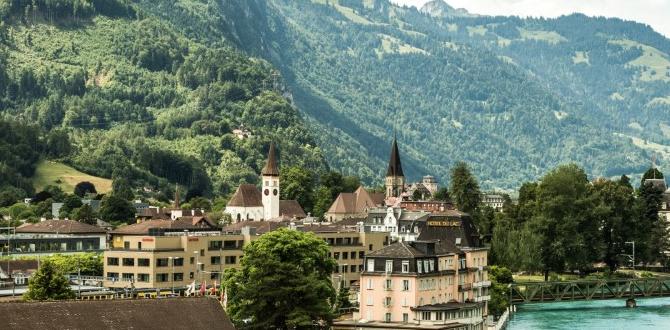Austria Hidden Gems Guide: Essential Discoveries – Your Practical Path to Unforgettable Austrian Adventures.
Dreaming of Austria but want to skip the crowded tourist trails? You’re in the right place! Many imagine Vienna’s grand palaces or Salzburg’s musical charm, and while those are wonderful, Austria holds so much more. Sometimes finding those truly special, less-traveled spots can feel overwhelming. This guide is here to make it easy! We’ll uncover Austria’s secret treasures, offering simple steps to plan your unique journey. Get ready to discover the magic beyond the postcards with practical tips and easy-to-follow advice.
Why Explore Austria’s Hidden Gems?
Austria is a country celebrated for its imperial history, stunning alpine landscapes, and vibrant culture. While iconic cities like Vienna and Salzburg draw millions annually, their charm can sometimes be outshined by the sheer volume of visitors. Venturing off the beaten path allows for a more authentic and personal experience. You get to connect with local life, discover breathtaking scenery without the crowds, and create memories that feel truly your own.
Imagine stumbling upon a serene mountain village, a secluded waterfall, or a quirky local festival. These are the moments that transform a good trip into an exceptional one. This guide will help you discover those special places, ensuring your Austrian adventure is both comfortable and unforgettable. We’ll focus on practical ways to find and enjoy these less-common destinations, making your planning stress-free.
Planning Your Austrian Off-the-Beaten-Path Adventure
The first step to uncovering Austria’s hidden gems is understanding how to look for them. It’s not about finding secret maps; it’s about smart research and openness to serendipity. We’ll break down the process into simple, actionable steps.
1. Research Beyond the Top Attractions
Start with a broad understanding of Austria’s regions. Instead of just searching for “Vienna attractions,” try “Salzkammergut lakes” or “Styrian wine regions.” This opens up a world of possibilities.
- Use Local Tourism Websites: Each Austrian state (Bundesland) has its own tourism board. These sites are goldmines for information on local events, hiking trails, and less-known villages. For example, the official Austria tourism website is a great starting point, but don’t stop there!
- Explore Regional Blogs and Forums: Look for travel blogs focusing on specific Austrian regions. Online travel forums or Facebook groups dedicated to Austrian travel can also offer insider tips.
- Consult Guidebooks (with a twist): While traditional guidebooks highlight popular spots, look for sections on “local life,” “day trips from X,” or “lesser-known sights.”
2. Embrace Regional Diversity
Austria is incredibly diverse geographically and culturally. Understanding these differences will help you choose areas that resonate with your interests.
- Alpine Majesty: Think of Tirol and Vorarlberg for dramatic mountain scenery, challenging hikes, and charming alpine villages.
- Lakes and Mountains: The Salzkammergut region, spanning Upper Austria, Salzburg, and Styria, is home to crystal-clear lakes and picturesque towns.
- Rolling Hills and Vineyards: Styria and Burgenland offer a gentler landscape, famous for their wine and pumpkin seed oil.
- Historical Charm: Beyond Vienna, cities like Graz, Innsbruck, and Linz have their own unique history and culture.
3. Prioritize Your Interests
What do you love most about travel? Tailor your hidden gem hunt to your passions.
- For Nature Lovers: Focus on national parks like Hohe Tauern, hiking trails in untouched valleys, or scenic drives through less-trafficked mountain passes.
- For History Buffs: Seek out smaller castles, medieval towns not on the main tourist circuit, or historical villages with well-preserved architecture.
- For Foodies: Explore regions known for specific culinary traditions, visit local markets in smaller towns, or seek out traditional “Buschenschanken” (wine taverns).
- For a Relaxing Escape: Look for quiet spa towns, secluded lakeshores, or rural guesthouses away from major cities.
Essential Austria Hidden Gems: Discoveries Awaiting You
Now, let’s dive into some specific regions and places that often fly under the radar but offer incredible experiences. These are curated with practicality and comfort in mind, ensuring you can enjoy them with ease.
1. Hallstatt’s Quieter Cousin: Gosau
Hallstatt is undeniably beautiful, but its popularity can be intense. Just a short drive away is the village of Gosau, located on the northern edge of the Dachstein mountains. It offers the same stunning alpine scenery and crystal-clear lake, but with a much more peaceful ambiance.
- What to Do: Hike around the Gosausee lakes (Oberer and Unterer Gosausee), enjoy panoramic views from the Dachstein Krippenstein cable car (which also leads to the Five Fingers viewing platform, though this can get busy), and explore the charming village itself.
- Why it’s a Gem: Offers breathtaking Hallstatt-like vistas minus the crowds, perfect for nature walks and photography.
- Traveler Tip: Consider staying overnight in Gosau for a truly tranquil experience.
2. The Enchanting Wachau Valley (Beyond the Main Towns)
While towns like Dürnstein are well-known in the Wachau Valley (a UNESCO World Heritage site), explore the smaller villages nestled along the Danube River. The entire valley is a wonderland for wine lovers and those who appreciate scenic river landscapes.
Consider exploring:
- Spitz: A picturesque village known for its steep vineyards and local wine.
- Arnsdorf: A tiny hamlet with historic churches and a quiet atmosphere.
- Weißenkirchen in der Wachau: Offers a charming town square and proximity to many vineyards.
What to Do: Cycle along the Danube cycle path, visit local wineries for tastings (weingutetiketts.at provides a great overview of wine regions), take a boat trip, or hike up to lesser-known castle ruins.
Why it’s a Gem: A celebrated wine region that retains its authentic charm with a little exploration beyond its most famous spots.
3. The Colorful Charm of Graz
Austria’s second-largest city, Graz, often gets overlooked by visitors flocking to Vienna. It’s a vibrant university city with a UNESCO-listed Old Town, a unique blend of Renaissance and Baroque architecture, and a decidedly more relaxed vibe than the capital.
What to Do:
- Ascend the Schlossberg (Castle Hill) for panoramic city views – take the funicular for ease!
- Wander through the colorful alleys of the Old Town.
- Visit the Kunsthaus Graz (modern art museum) for its striking architecture.
- Explore the Murinsel (Island in the Mur), an artificial island with a café and amphitheater.
- Sample Styrian specialties like pumpkin seed oil and local wines.
Why it’s a Gem: Offers all the cultural richness of a major European city but with a friendly, manageable scale and a distinctively local feel. It’s a foodie paradise with a laid-back atmosphere.
External Link: Learn more about Austria’s rich cultural heritage on the UNESCO World Heritage List entry for Graz.
4. The Serene Tyrolean Alps: St. Anton am Arlberg (Summer Edition)
While St. Anton is famous as a premier ski resort, its beauty in the summer is often understated. Without the ski crowds, it transforms into a hiker’s paradise with stunning alpine meadows and challenging trails.
- What to Do: Hike to alpine huts, explore the Verwallsee lake, enjoy the crisp mountain air, and discover incredible wildflowers. The Arlberg region offers numerous marked trails for all fitness levels.
- Why it’s a Gem: Experience world-class alpine scenery and infrastructure without the winter price tags or crowds. It’s pure mountain bliss.
- Traveler Tip: Many hotels offer attractive summer packages.
5. The Thermal Paradise of Loipersdorf (Styria)
For a truly relaxing escape and a taste of Austrian wellness culture, head to southern Styria. Loipersdorf is renowned for its thermal spas and vineyards, offering a perfect blend of relaxation and local flavors.
- What to Do: Indulge in the thermal baths at Therme Loipersdorf, explore the rolling hills and vineyards of Southern Styria, and enjoy the region’s culinary delights at local farms and Buschenschanken.
- Why it’s a Gem: A peaceful retreat focused on health and gastronomy, far from bustling tourist centers. Perfect for unwinding.
Practical Tips for Stress-Free Travel
Traveling to lesser-known spots can sometimes feel like a challenge, but with a few smart strategies, you can ensure your trip is comfortable and enjoyable, whether you’re traveling solo, with family, or managing specific needs.
Packing Essentials
For exploring diverse terrains, packing smart is key. Think layers and versatility!
- Comfortable Walking Shoes: Non-negotiable for exploring villages and hiking trails.
- Rainproof Jacket: Austrian weather can change quickly, even in summer.
- Daypack: For carrying water, snacks, and layers during day trips.
- Reusable Water Bottle: Tap water is safe and delicious across Austria.
- European Plug Adapter: Essential for charging electronics.
- Basic First-Aid Kit: Including plasters, antiseptic wipes, and any personal medication.
Comfort and Convenience for All Travelers
At Journey Essentials, we understand that comfort is paramount for an enjoyable trip. For families traveling with children, or adults who may need extra support, planning ahead ensures peace of mind.
- Child Diapers & Supplies: If you’re traveling with young children, packing a sufficient supply of diapers, wipes, and changing essentials is crucial. Many travelers find it easier to pack a carry-on bag specifically for these items for quick access during transit. Consider options like Depend adult briefs or specific child brands for ease of use and reliability, allowing for more focus on exploration and less on worrying about supplies.
- Travel-Friendly Adult Diapers: For adults who require incontinence products, discreet and comfortable options are available. Brands offer pull-up styles or briefs that are breathable and absorbent, ideal for long journeys or active sightseeing days. Staying hydrated is important, and having reliable products ensures you can do so without concern.
- Snacks: Keeping a stash of non-perishable snacks is always a good idea, especially when exploring areas where quick food options might be limited.
- Navigation Tools: Download offline maps for the regions you plan to visit. Apps like Google Maps or Maps.me are invaluable.
Getting Around
Austria has an excellent public transportation system, but exploring hidden gems sometimes requires a bit more flexibility.
- Trains: Austria’s national railway company, ÖBB, is incredibly efficient. Book in advance for potential savings.
- Buses: Local buses connect smaller villages. Check schedules carefully, as they can be less frequent than in cities.
- Car Rental: For maximum flexibility to reach remote areas, renting a car is often the best option. Be aware of vignette requirements for Austria’s highways. You can purchase a vignette easily online or at border crossings. Learn more about vignette purchase options on the official ASFINAG website.
- Ferries: In lake regions like the Salzkammergut, ferries can be a scenic and practical way to travel between towns.
Navigating Local Culture and Etiquette
Austrians are generally polite and appreciate visitors who make an effort to respect their customs. Simple gestures go a long way.
Key Phrases to Know:
- Hello: Hallo (informal), Guten Tag (formal)
- Thank You: Danke
- Please: Bitte
- Excuse Me: Entschuldigung
- Yes/No: Ja/Nein
- Do you speak English?: Sprechen Sie Englisch?
Using these phrases can make interactions smoother and more pleasant.
Dining Etiquette:
- When dining in a restaurant, wait to be seated.
- Tipping is appreciated but not always mandatory; a small tip for good service (around 5-10%) is common.
- It’s customary to greet the restaurant staff when entering and leaving.
Respecting Nature:
When exploring natural areas, always follow the “leave no trace” principle. Stick to marked trails, do not disturb wildlife, and take all your rubbish with you. Austria takes great pride in its natural beauty.
Table: Comparing Hidden Gem Regions
To help you decide where to go, here’s a quick comparison of a few of the less-common regions, highlighting their appeal.
| Region | Main Appeal | Best For | Traveler Comfort Notes |
|---|---|---|---|
| Gosau (Salzkammergut) | Alpine lake and mountain scenery, peaceful village life | Nature lovers, photographers, families seeking tranquility | Easy to access via Hallstatt region, well-marked trails, convenient amenities in village. |
| Spitz & Environs (Wachau Valley) | Vineyards, Danube River, charming medieval villages | Wine enthusiasts, cyclists, history buffs | Excellent cycling path along the Danube, boat tours, many wineries with tasting rooms. |
| Graz & Southern Styria | Renaissance architecture, vibrant city life, thermal spas, wineries | Urban explorers, foodies, those seeking relaxation | Good public transport within Graz, car recommended for exploring surrounding wineries and spas. |
| St. Anton am Arlberg (Summer) | High alpine scenery, hiking, wildflower meadows | Active hikers, mountain enthusiasts, nature admirers | Cable cars operate in summer, well-maintained trails, mountain huts offer refreshments. Consider packing layers for altitude changes. |
Frequently Asked Questions About Austria’s Hidden Gems
Is it easy to travel to Austria’s hidden gems without a car?
Yes, it is! Austria has a fantastic public transport network. Trains and regional buses can get you to most smaller towns and villages. For more remote hiking areas, a car offers flexibility, but it’s not always essential. Always check local bus schedules in advance, as they can be infrequent.
When is the best time to visit Austria’s hidden gems?
The shoulder seasons – spring (April-May) and autumn (September-October) – are often ideal. You’ll find fewer crowds, pleasant weather for exploring, and beautiful scenery. Summer (June-August) is popular for hiking and lakeside activities, while winter (December-March) is perfect for snowy landscapes and winter sports, with many areas offering a quieter experience than major resorts.
Are these hidden gem locations suitable for families with young children?
Absolutely! Many of these areas are very family-friendly. Lakes like Gosausee, charming villages in the Wachau, and the parks in Graz offer gentle activities. For comfort, ensure you pack child-friendly snacks and consider bringing a comfortable child carrier for trails if your little ones are too young to walk long distances.
What are some key things to pack for a hidden gem trip in Austria?
Comfortable, sturdy walking shoes are a must. Pack layers of clothing, including a waterproof jacket, as the weather can be unpredictable. A daypack for essentials like water, snacks, and a first-aid kit is also crucial. Don’t forget a reusable water bottle and a European plug adapter!
How can I find local food experiences in these less-visited areas?
Look for local markets (Wochenmarkt) in towns. In wine regions like Styria and Wachau, seek out “Buschenschanken” or “Heuriger” – traditional taverns serving local wine and small dishes. Restaurants in smaller villages are often family-run and offer authentic regional cuisine. Asking locals for recommendations is also a great strategy!







